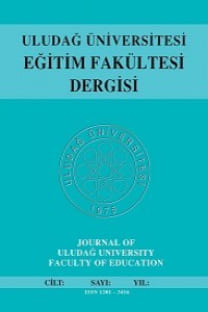A study on the effects of the cooperative learning method in science and technology education on the students' attitude: Bursa model
Fen ve teknoloji öğretiminde işbirlikli öğrenme yönteminin öğrenci tutumuna etkileri üzerine bir çalışma: Bursa örneği
___
- Açıkgöz, K. Ü. 1992. İşbirlikli Öğrenme: Kuram, Araştırma, Uygulama. Malatya: Uğurel Matbaası.
- Bilgin, İ. and Geban, Ö. 2004. İşbirlikli Öğrenme Yöntemi ve Cinsiyetin Sınıf Öğretmenliği Öğretmen Adaylarının Fen Bilgisi Dersine Karşı Tutumlarına, Fen Bilgisi Öğretimi-I Dersindeki Başarılarına Etkisinin İncelenmesi. Hacettepe Üniversitesi Eğitim Fakültesi Dergisi, 26, 9-18.
- Bourner, J., Hughes, M. and Bourner, T. 2001. First-Year Undergraduate Experiences of Group Project Work. Assessment and Evaluation in Higher Education, 26, 19-39.
- Demirel, Ö. 2009. Öğretme Sanatı. (14. Baskı). Ankara; Pegem Akademi Yayınları.
- Doolittle P. 1997. Vygotsky's Zone of Proximal Development as a Theoretical Foundation for Cooperative Learning. Journal on Excellence in College Teaching, 8(1), 83-103.
- Doymuş, K., Şimşek, Ü. and Bayrakçeken, S. 2004. İşbirlikçi Öğrenme Yönteminin Fen Bilgisi Dersinde Akademik Başarı ve Tutuma Etkisi. Türk Fen Eğitimi Dergisi, Sayı 2, 103-115.
- Evans, P, Gate wood, T. and Green, G. 1993. Cooperative learning: Passing fad or long-term promise? Middle School Journal, 24(3), 3-7.
- Fidan, N. and Erden, M. 1994. Eğitime giriş. Ankara: Meteksan Matbaacılık.
- Gömleksiz, M. 1997. Kubaşık Öğrenme: Temel Eğitim Dördüncü Sınıf Öğrencilerinin Matematik Başarısı ve Arkadaşlık İlişkileri Üzerine Deneysel Bir Çalışma. Adana: Baki Kitabevi.
- Gümüş, O. 2006. İşbirliğine Dayalı Öğrenme Yaklaşımının İlköğretim Dördüncü Sınıf Türkçe Dersi Hedeflerinin Kazandırılması ve Öğrenci Başarısına Etkisi. Yayınlanmamış Yüksek Lisans Tezi. Gazi Üniversitesi, Eğitim Bilimleri Enstitüsü.
- Herreid, C. F. (1998). Why Isn't Cooperative Learning Used to Teach Science? Bioscience, 48(7), 553-560.
- İflazoğlu, A. 2003. Çoklu Zekâ Kuramı Destekli Kubaşık Öğrenme Yönteminin İlköğretim 5. Sınıf Öğrencilerinin Fen Bilgisi Dersindeki Akademik Başarı ve Tutumlarına Etkisi. Çukurova Üniversitesi. Sosyal Bilimler Enstitüsü. Yayınlanmamış Doktora Tezi.
- Johnson, D.W. and Johnson, R.T. 1974. "Instructional Goal Structure: Cooperative, Comperitive or Intividualistic". Review of Teducational Research, 44, 213-240.
- Johnson, D. W. 1981. "Student-student interaction: the neglected variable in education". Educational Researcher, JO, 5-10.
- Johnson, D. W. ve Johnson, R. T. 2000. Cooperative Learning Methods: A Meta Analysis, Minesota.
- Mattheews, M. 1992. Gifted Students Talk About Cooperative Learning. Educational Leadership.
- Millis, B.J. 1996. "Cooperative learning", http://www.utc.edu/teaching-resourcecenter/ (Erişim Tarihi: 23.05.2006)
- Nhu, L. T. S. 1999. A Case Study of Cooperative Learning in Inorganic Chemistry Tutorials at the Wietnam National University-Ho Chi Minh. Yayınlanmış Yüksek Lisans Tezi. Comprehensive University-Ho Chi Minh City.
- Sharan, S. 1980. "Cooperative learning in small groups: Recent methods and effects on achievement attitudes and ethnics relations". Review of Educational Research, 50, 241 -271.
- Slavin, R. E. 1980. Cooperative Learning. Review of Education Research, 50,2,315-342.
- Slavin, R. E. 1987. "Cooperative learning and the cooperative school". Educational Leadership, 45-3,1-13.
- Slavin, R. E. 1990. Comprehensive Cooperative Learning Methods: Embedding Cooperative Learning in the Curriculum and School, Cooperative Learning: Theory and Research Slavin, R.E, 1990, (editor: Shlomo Sahran), New York.
- Yaman, F. 2008. İlköğretim 6. Sınıf Öğrencilerine "Madde ve Isı" Konusunda Fen ve Teknoloji Hedeflerinin Kazandırılmasında İşbirlikçi Öğrenme Kuramının Etkisi. Yüksek Lisans Tezi.
- Yayın Aralığı: 3
- Başlangıç: 1986
- Yayıncı: Bursa Uludağ Üniversitesi Eğitim Fakültesi
Peacemaking skills: Anatolian sufi verses and the peace education
Yabancı Dilde Konuşma Becerisi: Kaygıyı Yenmek
Duyarlı Sevgi Ölçeği: Geçerlik ve Güvenirlik Çalışması
Duygu GÜR ERDOĞAN, Demet ZAFER GÜNEŞ
Fen ve Teknoloji Dersi Öğretmenlerinin “Canlılarda Üreme ve Gelişme” Konusu Hakkındaki Görüşleri
Dilek ZEREN ÖZER, Muhlis ÖZKAN
Fransızca Dil Öğretiminde Kullanılan Aktiviteler Öğrencilerin Motivasyonlarını Etkiler Mi?
Fen ve teknoloji dersi öğretmenlerinin "canlılarda üreme ve gelişme" konusu hakkındaki görüşleri
ZEREN Dilek ÖZER, Muhlis ÖZKAN
İlköğretim Öğrencilerinin Geri Dönüşümle İlgili Bilgileri ve Geri Dönüşüm Davranışları
The views of primary and preschool education teachers on classroom motherhood
